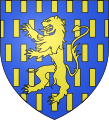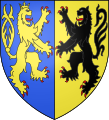| Duchy of Guelders. Hertogdom Gelre (nl ). Herzogtum Geldern (de ). Ducatus Geldriae (Latin ) | |||||||||
|---|---|---|---|---|---|---|---|---|---|
| 1096–1795 | |||||||||
 Coat of arms Coat of arms | |||||||||
 Duchy of Guelders and the County of Zutphen, about 1350 Duchy of Guelders and the County of Zutphen, about 1350 | |||||||||
| Status | Duchy | ||||||||
| Capital | Geldern | ||||||||
| Government | Feudal monarchy | ||||||||
| Historical era | Middle Ages, Renaissance | ||||||||
| • Gerard I first. Count of Guelders | 1096 | ||||||||
| • Raised to duchy | 1339 | ||||||||
| • Hel d by Jülich | 1393–1423 | ||||||||
| • Acquired by Burgundy | 1473 | ||||||||
| • Lower Quarters to. Dutch Republic | 1581 | ||||||||
| • Annexed by France | 1795 | ||||||||
| |||||||||
Gueldersor Gueldres(Dutch : Gelre, German : Geldern) is a historical county, later duchy of the Holy Roman Empire, located in the Low Countries.
Герцогство было названо в честь города Гельдерн (Гельдер) в современной Германии. Хотя нынешняя провинция Гелдерланд (англ. Также Guelders) в Нидерландах занимает большую часть территории, бывшее герцогство также входило в состав нынешней голландской провинции Лимбург а также те территории в современном немецком государстве Северный Рейн-Вестфалия, которые были приобретены Prussia in 1713.
Four parts of the duchy had their own centres, as they were separated by rivers:
spatially separated from the Lower Quarters (Gelderland):
The county emerged about 1096, when Gerard III of Wassenberg was first documented as "Count of Guelders". It was then located on the territory of Lower Lorraine, in the area of Geldern and Roermond, with its main stronghold at Montfort (built 1260). Count Gerard's son Gerard II in 1127 acquired the County of Zutphen in northernHamaland by marriage. In the 12th and 13th century, Guelders quickly expanded downstream along the sides of the Maas, Rhine, and IJssel rivers and even claimed the succession in the Duchy of Limburg, until it lost the 1288 Battle of Worringen against Berg and Brabant.
 Guelders officer of arms wearing a tabard of the shield, c. 1395
Guelders officer of arms wearing a tabard of the shield, c. 1395Guelders was often at war with its neighbours, not only with Brabant, but also with графство Голландия и епископство Утрехт. Однако его территория росла не только благодаря успехам в войне, но и благодаря процветанию в мирное время. Например, большая часть Велюве и города Неймеген были переданы в качестве залога Гельдерс их безденежными правителями. В отдельных случаях в обмен на ссуды из казначейства Гельдерса епископ Утрехта предоставлял налогообложение и администрирование Велюве, а ВильгельмII – Count of both Holland and Zeeland, and who was elected anti-king of the Holy Roman Empire (1248–1256) – similarly granted the same rights over Nijmegen; as neither ruler proved able to repay their debts, these lands became integral parts of Guelders.
In 1339 Count Reginald II of Guelders (also styled Rainald), of the House of Wassenberg, was elevated to the rank of Duke by Emperor Louis IV of Wittelsbach. After theWassenberg line became extinct in 1371 following the deaths of Reginald II's childless sons Edward II (on 24 August, from wounds suffered in the Battle of Baesweiler ) and Reginald III (on 4 December), the ensuing Guelders War of Succession saw William I of Jülich emerge victorious. William was confirmed in the inheritance of Guelders in 1379, and from 1393 onwards held both duchies in personal union (in Guelders as William I, and in Jülich asВильгельм III). В 1423 году Гельдерс перешел к дому Эгмондов, который получил признание своего титула от императора Сигизмунда Люксембургского, но не смог избежать политических распрей и междоусобных конфликтов, которые так мучили предшествовавший Дому Юлих-Хенгебахов, и в особенности давление со стороны экспансионистских правителей герцогства Бургундского. Первый герцог Эгмонда, Арнольд, пострадал от восстания своего сына Адольфа и был им заключенный последним в 1465 году. Адольф, который пользовался поддержкой бургундского герцога Филиппа III («Доброго») и четырех крупных городов Гелдерса во время своего восстания, не желал идти на компромисс с его отец, когда этого потребовал преемник Филиппа, герцог Карл Смелый. Чарльз захватил и заключил в тюрьму герцога Адольфа в 1471 году и восстановил Арнольда на троне герцогства Гельдерс. Затем Чарльз купил возврат (то есть право наследования e throne) from Duke Arnold, who, against the will of the towns and the law of the land, pledged his duchy to Charles for 300,000 Rhenish florins. The bargain was completed in 1472–73, and upon Arnold's death in 1473, Duke Charles added Guelders to the "Low Countries" portion of his Valois Duchy of Burgundy. Upon Charles' defeat and death at the Battle of Nancy in January 1477, Duke Adolf was released from prison by the Flemish, but died the same year at the h Глава фламандской армии, осаждающей Турне, после того, как Гельдерские штаты снова признали его герцогом. Впоследствии Гельдерсом правил Габсбург император Священной Римской империи Максимилиан I, муж дочери и наследника Карла Смелого, Мэри.
Последним независимым герцогом Гельдерским был сын Адольфа. Карл Эгмондский (1467–1538, годы правления 1492–1538), выросший при бургундском дворе Карла Смелого и сражавшийся за Габсбургский дом в битвах против the armies of Charles VIII of France, until being captured in the Battle of Béthune (1487) during the War of the Public Weal (also known as the Mad War). In 1492, the citizens of Guelders, who had become disenchanted with the rule of Maximilian, ransomed Charles and recognized him as their Duke. Charles, now backed by France, fought Maximilian's grandson Charles of Habsburg (who became Holy Roman Emperor, as Charles V, in 1519) in the Guelders Wars and expanded his realm further north, to incorporate what is now the Province of Overijssel. He was not simply a man of war, but also a skilled diplomat, and was therefore able to keep his independence. He bequeathed the duchy to Duke William the Rich of Jülich-Cleves-Berg (also known as Wilhelm of Cleves). Following in the footsteps of Charles of Egmond, Duke William formed an alliance with France, an alliance dubiously cemented via his political marriage toФранцузский король Франциск I племянница Жанна д'Альбре (которую, как сообщается, пришлось заставить подчиниться браку, а затем телесно отнести к алтарю констебль Франция, Анн де Монморанси ). Этот союз воодушевил Вильгельма оспорить притязания императора Карла V на Гельдерс, но французы, активно участвовавшие на нескольких фронтах в длительной борьбе против габсбургского «окружения» Франции, оказались менее надежными, чем Duke's ambitions required, and he was unable to hold on to the duchy; in 1543, by the terms of the Treaty of Venlo, Duke William conceded the Duchy of Guelders to the Emperor. Charles united Guelders with the Seventeen Provinces of the Habsburg Netherlands, and Guelders finally lost its independence.
Charles V abdicated in 1556 and decreed that the territories of the Burgundian Circle should be held by the Spanish Crown. When the Netherl ands revolted against King Philip II of Spain in the Dutch Revolt, the three northern quarters of Gelderland joined the Union of Utrecht and became part of the United Provinces upon the 1581 Act of Abjuration, while only the Upper Quarter remained a part of the Spanish Netherlands.
At the Treaty of Utrecht, ending the War of the Spanish Succession in 1713, the Spanish Upper Quarter was again divided bet ween Prussian Guelders (Geldern, Viersen, Horst, Venray ), the United Provinces (Venlo, Montfort, Echt ), Austria (Roermond, Niederkrüchten, Weert ), and the Duchy of Jülich (Erkelenz ). In 1795 Guelders was finally conquered and incorporated by the French First Republic, and partitioned between the départements of Roer and Meuse-Inférieure.
Герб региона со временем менялся.

до 1236 года

с 1236 года

с 1276 года

Юлих-Гельдерс после 1393 года
Уильям Тэтчер, главный герой фильма 2001 года A Knight's Tale в исполнении Хита Леджера, который утверждал, что он сэр Ульрих фон Лихтенштейн из Гелдерланд, чтобы иметь вид знатного происхождения и, таким образом, иметь право на участвовать в рыцарских турнирах.
Действие происходит в конце 1460-х годов, главный герой романа Рафаэля Сабатини 1929 года «Романтический принц» - граф Энтони Гельдерский, старший сын герцога Арнольда и брат Адольфа, «с тех пор счастливо исчез». Сабатини вплетает в историю исторических персонажей и события того периода.
Фолк / метал-группа Heidevolk, базирующаяся в Гелдерланде, сочинила и исполнила ряд песен о Гелре / Гельдерсе, в том числе современный гимн "Het Gelders Volklied".
| Wikimedia Commons has media related to Guelders. |